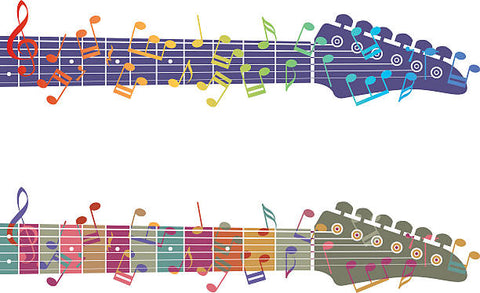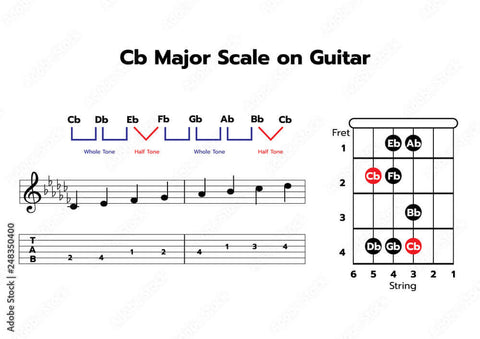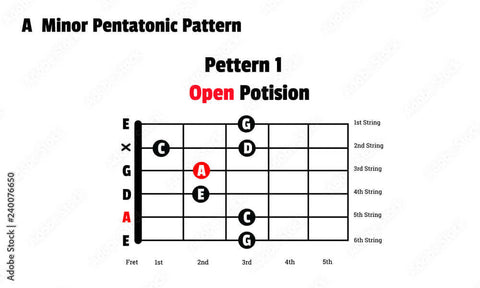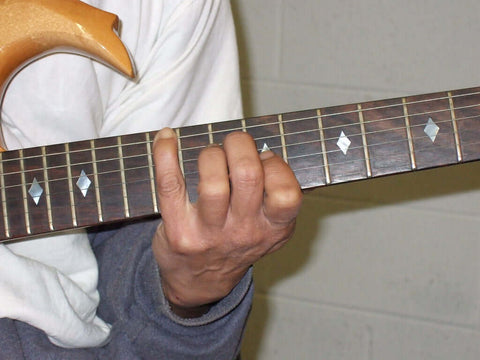Introduction to Guitar Scales

Learning the scales of the guitar is a necessary step for any person who wants to become a musician. A fundamental component of music theory, scales are essential for comprehending melody, harmony, and improvisation. Scales constitute the cornerstone of music theory. In this post, we will discuss the fundamentals of guitar scales for beginners, including how to comprehend music theory and how to properly practice scales.
1. Understanding Basic Music Theory

Notes and Intervals
It is vital to have a solid understanding of the principles of music theory before beginning to work with scales. A sound that has a particular pitch and duration is referred to as a note, while the distance that separates two notes is referred to as an interval. Acquiring an understanding of these concepts is essential in order to acquire knowledge of scales.
Major and Minor Scales
In Western music, the major scale is considered to be the most fundamental scale overall. The composition is made up of seven notes and is organized in a certain pattern of intervals. The minor scale, on the other hand, is characterized by a unique pattern and is utilized frequently in a variety of musical styles.
2. Essential Guitar Scales for Beginners

Major Scale:

In Western music theory, the major scale is considered to be the foundational scale. Mastering this scale will allow you to access an infinite number of tunes and chord progressions. It is important to practice the major scale in a variety of keys so that you may become familiar with its pattern and tone.
Major Scale Formula: A precise pattern of whole steps (W) and half steps (H) is followed by the major scale, as indicated by the formula called the major scale. In order to construct a major scale, the formula that is used is W-W-H-W-W-W-H. This indicates that you begin on a note, then proceed to advance up one full step, then another whole step, then a half step, and so on until you reach the end of the scale.
Major Scale Sound: A bright, joyful, and uplifting tone is characteristic of major scales. Major scales have a large scale. In order to generate melodies and harmonies, they are frequently utilized in the music genres of pop, rock, country, and jazz.
Example: Take, for instance, the C major scale as an example. The notes that make up the C major scale are as follows: C-D-E-F-G-A-B-C, the first note being C. With the exception of E to F and B to C, which are half steps (one fret apart), each note is apart by a complete step, which is equivalent to two frets on the guitar.
Typical Major Scales Played on the Guitar: Despite the fact that the C major scale is a typical reference, you can begin playing major scales on the guitar by beginning with any note. The major scales G major, D major, A major, E major, and so on are among the most often utilized major scales.
Numerous chord progressions in music are built on major scales, which serve as the foundation for these progressions. There is a sense of resolution and stability that is created by chords that are drawn from the major scale.
Minor Pentatonic Scale:

An additional scale that is essential for guitarists to master is the minor pentatonic scale. The blues, rock, and pop music all make extensive use of this scale, which is more straightforward than the major scale. Acquiring a command of the minor pentatonic scale paves the way for improvisation and soloing musical expression.
Formula for the Natural Minor Scale: The natural minor scale, which is sometimes referred to as the Aeolian mode, features a pattern that is composed of the letters W-H-W-W-H-W-W. This indicates that it is structured in a manner that is comparable to that of the major scale, but this scale begins at a different point and has different intervals between the notes.
Sound of Minor Scales: The sound of minor scales is characterized as being melancholy, dark, and introspective. Rock, metal, blues, and classical music are all examples of genres that frequently make use of them to communicate feelings and depth.
For illustration, let's have a look at the A minor scale. A, B, C, D, E, F, G, and A are the notes that make up the A minor scale. In accordance with the scale formula, each note is separated by either a whole step or a half step, just like it is in the major scale.

Minor Scale Variations In addition to the natural minor scale, there are a few other variations of the minor scale. These variations include the harmonic minor scale and the melodic minor scale. As a result of these scales, certain notes undergo modifications, which results in the creation of distinct harmonic and melodic tastes.
There is a relative minor scale for every major scale, and vice versa. They are referred to as relative major and minor scales. Although they begin on separate notes, they both have the same key signature despite this. As an illustration, the relative minor of C major is composed of A minor, while the relative major of A minor is composed of C major.

When it comes to chord progressions, minor scales play a significant role in the creation of tension and emotional depth. Chords that are produced from the minor scale have the potential to offer a layered and intricate quality to musical compositions.
Blues Scale:

The blues scale is a type of scale that is fundamental to blues music and is also utilized extensively in a variety of other musical genres, including rock, jazz, and funk. Guitar solos, melodies, and improvisations all benefit from the addition of this peculiar taste, which is defined by a sound that is both expressive and soulful.
Blues Scale Structure: Formula: Blues Scale Structure: One of the six notes that make up the blues scale is the root, followed by the minor third, the fourth, the reduced fifth (also known as the "blues note"), the fifth, and finally the minor (7). The building blocks of a blues scale are represented by the formula 1-b3-4-b5-5-b7. The letter "b" is used to denote a flat note, which indicates that it is one semitone lower than the natural sound.
Take, for instance, the A blues scale as an illustration as an example. A-C-D-Eb-E-G is the series of notes that make up the A blues scale. Please take note of the addition of the Eb note, which is the blues note and is responsible for the distinctive bluesy tone that the scale produces.
Blues Scale Characteristics include the following:

Blues Note: The blues scale is distinguished from other scales by the presence of the diminished fifth, sometimes known as the "blues note" (Eb in the example of the A blues scale). This note gives melodies and solos a particular bluesy tone while also adding tension to the performance.
While playing the guitar, techniques such as bending and vibrato are particularly useful due to the nature of the blues scale, which lends itself well to these methods. Instrumentalists are able to imitate the vocal-like elements that are frequently seen in blues music by employing these techniques, which enable them to infuse their playing with emotion and expression.
There are many different chord progressions that may be played over the blues scale, which makes it a versatile instrument. As a result of its ability to provide color and feeling to blues tunes in both major and minor keys, it is an extremely useful instrument for guitarists to use in a wide range of musical settings.
Call and Response: Blues music frequently makes use of a structure known as call and response, in which a melodic line known as the call is followed by a response performed by the musician. This interaction between various musical parts is made easier by the blues scale, which enables guitarists to engage in expressive improvisations and musical conversations since it fosters this interaction.
Application of the Blues Scale:
Soloing: When playing solos in blues and blues-influenced genres, guitarists frequently employ the blues scale as the foundation for their solos. Its straightforwardness and expressiveness make it suitable for players of all skill levels, from novices to seasoned veterans.
Improvisation: The blues scale serves as a framework for improvisation, enabling guitarists to create musical phrases that are both spontaneous and emotional within the context of blues chord progressions. It is a great scale for improvisatory exploration because to its naturally intuitive layout and the emotional aspects it possesses.
When it comes to blues, rock, and funk music, the blues scale is utilized not only for solos but also for the creation of melodies and riffs that are memorable and catchy. Because of its unique tone and emotional nature, it has the ability to immediately capture the attention of the listener and elicit a variety of feelings.
3. How to Practice Guitar Scales

Use of Metronome
A metronome is a useful tool for improving timing and rhythm when used in practice. As you grow more adept, begin at a tempo that is comfortable for you and progressively raise the speed as you progress. Your sense of time and precision will improve if you practice using a metronome on a regular basis.
Start Slow, Increase Speed Gradually
Accuracy is more crucial than speed when it comes to making progress in learning guitar scales. When you first start playing, take it gradually and concentrate on hitting each note cleanly. Increasing the tempo gradually while retaining accuracy is something you should do as your confidence grows.
Incorporate Scale Patterns
Discover a variety of scale patterns and positions on the fretboard by playing the guitar. Being able to perform scales in a variety of keys and locations is made possible by this. If you want to build versatility in your playing, you should try out a variety of fingerings and patterns.
4. Common Mistakes to Avoid

Ignoring Technique
Your progress can be hampered and you can become frustrated if you have poor technique. When practicing scales, it is important to pay attention to the correct posture, hand arrangement, and finger placement. In order to prevent constructing undesirable routines, it is important to pay attention to aspects such as finger independence and string muting.
Skipping Warm-Up
When it comes to preventing injuries and getting your fingers ready for practice, warm-up activities are absolutely necessary. In order to prepare yourself for the scales, you should first spend a few minutes performing basic exercises such as finger stretches and chromatic runs. Your muscles will be primed and your total performance will increase if you perform a suitable warm-up regimen.
Not Applying Scales to Music
Scales should not be practiced in isolation; rather, they should be applied to actual music. Explore the possibility of introducing scales into songs, chord progressions, and improvisations by carrying out experiments. Your comprehension of scales and the different ways in which they can be applied in music is strengthened as a result of this.
5. Benefits of Learning Guitar Scales

Improves Finger Dexterity
By practicing guitar scales on a regular basis, one can improve their finger dexterity and coordination. It will get easier for you to perform difficult passages and solos as you progress through the various scale patterns. Your fingers will become more nimble and responsive as you progress through these patterns.
Enhances Musical Vocabulary
The expansion of your musical vocabulary and comprehension of melody and harmony can be achieved via the study of scales. You get a greater familiarity with various musical intervals, chord progressions, and tonal relationships, which enables you to express yourself more creatively through the medium of music.
Boosts Creativity
Learning to play the guitar scales is a great way to inspire creativity and improvisation. Developing your own distinctive musical voice can be accomplished by experimenting with a variety of scale patterns and exploring different variations. Scales offer a structure for improvisation, which enables you to freely express your feelings and thoughts through the instrument you are playing or conducting.
Conclusion
Scales on the guitar are the fundamental elements that make up musical expression. Beginning musicians can establish a strong foundation for their musical journey by first being proficient in fundamental scales and then diligently practicing those scales. Keep in mind that you should concentrate on technique, include scales into your music, and take use of the creative opportunities that scales provide. You will soon be able to realize the full potential of your guitar playing if you persevere and dedicate yourself to the process.
FAQs
1. What are guitar scales?
Answer: Guitar scales are sequences of musical notes played in ascending or descending order. They form the basis of melody, harmony, and improvisation in music.
2. Why are guitar scales important for beginners?
Answer: Learning guitar scales helps beginners understand basic music theory, improve finger dexterity, and enhance creativity in playing.
3. How do I know which scale to learn first?
Answer: Beginners should start with the major scale, as it is the foundation of Western music theory. Once comfortable with the major scale, they can explore other scales like the minor pentatonic and blues scale.
4. How often should I practice guitar scales?
Answer: It's recommended to practice guitar scales daily, even if only for a short time. Consistent practice is key to mastering scales and improving overall playing ability.
5. Can I learn guitar scales without music theory knowledge?
Answer: While a basic understanding of music theory can be helpful, it's possible to learn guitar scales through practice and experimentation. However, learning music theory alongside scales can deepen your understanding and enhance your musicality.
Author bio:

Dr. Robin Alexander
Dr. Robin Alexander, an MD Pathologist and passionate guitarist, combines his love for music and science. As a guitar enthusiast, he shares valuable insights and tips on guitar playing here at Guitarmetrics, helping musicians enhance their skills and enjoy their musical journey.






